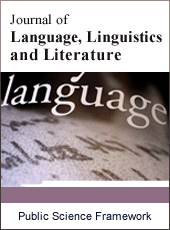Journal of Language, Linguistics and Literature
Articles Information
Journal of Language, Linguistics and Literature, Vol.1, No.4, Aug. 2015, Pub. Date: Aug. 12, 2015
The Arab World and the Westin the Post-Colonial Arabic Novel
Pages: 127-136 Views: 5349 Downloads: 1922
[01]
Najim A. Kadhim, Department of Arabic Language College of Arts, University of Baghdad, Baghdad, Iraq.
Being at the centre does not mean that those on t periphery (i.e., the Third World) automatically accept that the West is the master while they are the followers and subordinates. A certain attitude adopted by many Arabs towards the West derives from this unfair relationship, and accepting this as a fact undoubtedly means that those who can better convey this mind set are Arab artists, theorists, writers, and scholars in general. The chief literary discourse through which this peer group expresses this attitude and the thinking connected with it, e.g., opposing the unjust hegemonic equation in Arab-West relations, is the Arabic novel. The paper is based on the hypothesis that post-colonial Arabic novels, particularly those published during the past four decades, express rejection of the West as a hegemonic centre in its relation with the Arabs. In this regard, the dominant image of the West presented by the authors is mostly negative. Portrayed in the novels by western characters, the West and its hegemony will usually be opposed by the protagonists and other Arab characters. This, the paper believes, is one of the idealistic post-colonial discourses in which Arabs intellectuals engage.
Arabic, West, Novel, Colonialism, Post-Colonialism, Negative, Positive
[01]
‘Ali, ‘Awad, 2008: Halib al-Marins [Marine’s Milk], Amman: Dar Fadha’at Lilnashrwa Al-Tawzi’a.
[02]
‘Ashur, Radhwa, 1983: Al-Rihla: Yawmiyyat Taliba Misriyya fi Amrika [The Journey: Diary of an Egyptian Student in America], Beirut: Dar al-Adab.
[03]
Ashcroft, Bill, Gareth Griffiths and Helen Tiffin (eds.) 1995: The Post-Colonial Studies Reader, Abingdon: Routledge.
[04]
Al-Aswani, ‘Ala’, 2005: ‘Imarat Ya’qubian [The Yacoubian Building], Cairo: Maktabat Madbuli.
[05]
Azzuqa, Muhammad, 1988: Al-Thaljal-Aswad [The Black Snow] Beirut: al-Mu’ssasa al-‘ArabiyyaLildirasat wa al-Nashr.
[06]
Al-Bayyati, Mahmud, 2000: Al-Riqs‘ala al-ma’ [Dancing on Water], electronic copy.
[07]
Carpenter, M. and Bonnie J. Dow, 2010; “An Interview” letters, Robert Penn Warren Center for the Humanities, Vanderbilt University, Fall, Vol. 19, No. 1.
[08]
El-Enany, Rasheed, 2006; Arab Representations of the Occident, Abingdon and New York: Routledge.
[09]
Hadi, Maysalun, 2004: Al-Hududal-Barriyya[The Land Border], Beirut: al-Mu’ssasa al-‘ArabiyyaLildirasat wa al-Nashr.
[10]
2009,HulumFatih al-Lawn [A Rosy Dream], Beirut: al-Mu’ssasa al-‘Arabiyya Lildirasat wa al-Nashr.
[11]
2007: Nubu’tFir’awn [Pharoah’s Prophesy],Beirut: al-Mu’ssasa al-‘Arabiyya Lildirasat wa al-Nashr.
[12]
2010: Shay al-‘Arus [The Bride’s Tea], Beirut: al-Mu’ssasa al-‘ArabiyyaLildirasat wa al-Nashr.
[13]
‘Id, Raja’, 1998: “Liqa’ al-Hadharat fi al-Riwaya al-‘Arabiyya” [The Meeting of Civilizations in Arabic Novel], Cairo: Fusul, Vol. 2, No. 4, pp. 56-77.
[14]
Al-Hiti, Zuhair, 2009: Al-Ghubar al-Amriki [American Dust], Beirut: Dar al-Saqi Liltiba’a wa al-Nashr.
[15]
Ibrahim, Sun’ Allah, 2004: Amrikanli[An American], Cairo: Dar al-Mustaqbal al-‘Arabi.
[16]
Kadhim, Najim A., 2010: Al-Akhar fi al-Shi’r al-Arabi al-Hadith [The Other in Modern Arabic Poetry], Beirut: al-Mu’ssasa al-‘Arabiyya Lildirasat wa al-Nashr.
[17]
Khalifa, Sahar,1992: Mudakkaratimra’a ghayr waqi’yya[Memoir of an Unrealistic Woman], Beirut: Dar al-Adab.
[18]
1997: Al-mirath [The Inheritance], Beirut: Dar Al-Adab .
[19]
Khayyun, ‘Ali, 1987: Al-‘Azf fi makansakhib [Playing Music in a Loud Place], Baghdad: Dar al-Shu’n al-Thaqafiyya.
[20]
2005:“Nahnu wa al-Akhar fi al-Riwaya al-‘Arabiyya al-Mu’asira”, [We and the Other in Modern Arabic Novel], Baghdad: Majallat Kulliyyat Al-Adab, No.5, pp.71-109.
[21]
2007: Al-Riwayaal-‘Arabiyya al-Mu’asirawa al-Akhar [Al-Riwaya Al-Arabiyya al-Mu’asira and the Other], Irbid, Jordan: Alam al-Kutub al-Hadith.
[22]
Mamduh, ‘Alya, 2003:Al-mahbubat[The Beloved Women], Beirut: Dar al-Saqi .
[23]
Matar, Salim, 2001: Al-taw’amal-mafqud [The Lost Twin], Beirut: al-Mu’ssasa al-‘Arabiyya Lildirasat wa-al-Nashr.
[24]
Munif, ‘Abdulrahman, 1979: Sibaq al-Masafatal-Tawila [The Long-distance Race], Beirut: al-Mu’ssasa al-‘Arabiyya Lildirasat wa al-Nashr.
[25]
Mustaghanemi, Ahlam, 2003: ‘AbirSareer[A Crosser of a Bed], Beirut:Dar al-Adab.
[26]
Said, Edward, 1978: Orientalism, London: Routledge and Kegan Paul.
[27]
Said, Mahmud, 1998: Al-mawt al-Jamil [The Sweet Death], Damascus: Dar al-Mada Lilnashr wa al-Tawzi’.
[28]
Al-Saqr, Mahdi ‘Isa, 1987: Al-Shahidawaal-Zinji [The Witness and the Negro], Baghdad: Dar al-Shu’un al-Thaqafiyya al-‘Amma.
[29]
Soueif, Ahdaf, 2000: The Map of Love, New York:Anchor Books Edition.
[30]
Tahir, Baha’, 2006: Wahat al-Ghurub[Sunset Oasis], Cairo: Dar al-Hilal.
[31]
Tarabishi, George, 1979: Sharq wa Gharb; Rijoola wa Unutha [East and West; Virility and Femininity], Beirut: Dar al-Tali’a,.
[32]
Tawfiq, Zuhayr, 2003: “Surat al-Gharb‘inda al-‘Arab fi al-‘Asr al-Aadith’ [The Image of the West the Arabs have], Amman: Awraq, Nos. 16&17, pp.11-20.
[33]
Al-Tikriti,Naji, 1981: Nura[Noora], Baghdad: Dar al-Rasheed Lilnash.
[34]
Wali, Najim, 2009: entitled Mala’kat al-Junub [The Angels of the South], Dubai: Dar Klaim Lilnashr wa al-Tawzi’.
[35]
Yusuf, Abdulfattah Ahmad, 2007: ‘Sitratijiyyat al-Qira’afi al-Nassal-Thaqafi, [Strategies of Reading in the Cultural Text], Kuwait: ‘Alam al-Fikr, No. 1,p.167.

ISSN Print: 2381-7054
ISSN Online: 2381-7062
Current Issue:
Vol. 6, Issue 1, March Submit a Manuscript Join Editorial Board Join Reviewer Team
ISSN Online: 2381-7062
Current Issue:
Vol. 6, Issue 1, March Submit a Manuscript Join Editorial Board Join Reviewer Team
| About This Journal |
| All Issues |
| Open Access |
| Indexing |
| Payment Information |
| Author Guidelines |
| Review Process |
| Publication Ethics |
| Editorial Board |
| Peer Reviewers |


